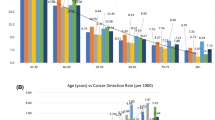Abstract
Objective: Some of the racial and ethnic variation in breast cancer incidence rates may reflect differential use of mammography. We report breast cancer rates using mammography and diagnostic data from five race/ethnicity groups.
Methods: Mammography data were analyzed for 573,751 women who received breast cancer screening between July 1991 and March 1998 from the National Breast and Cervical Cancer Early Detection Program (NBCCEDP). Abnormal mammography rates, breast cancer detection rates, and cancer stage distribution data are presented by race/ethnicity and screening round (first or subsequent).
Results: For the first screening round, percentages of abnormal mammographies ranged from 7.3% among black women to 9.3% among Asian/Pacific Islander women. Cancer detection rates ranged from 4.9 cancers per 1000 mammograms for Hispanic and American Indian/Alaska Native (AI/AN) women to 7.7 per 1000 for white women. Subsequent round rates were lower but varied similarly. AI/AN women had the highest percentage (68%) of first-round cancers detected in the early stage (range for the other groups: 52–63%).
Conclusions: Breast cancer detection rates for racial and ethnic groups in this program varied less than published population-based incidence rates. Differential use of mammography among these groups may account for some of the variation reported for breast cancer incidence.
Similar content being viewed by others
Reference
Miller BA, Kolonel LN, Bernstein L et al. (eds) (1996) Racial/ Ethnic Patterns of Cancer in the Unites States 1988-1992. Bethesda, MD: National Cancer Institute. NIH Publ. No. 96-4104.
Frost F, Tollestrup K, Hunt WC, Gilliland F, Key CR, Urbina CE (1996) Breast cancer survival among New Mexico Hispanic, American Indian, and non-Hispanic white women (1973-1992). Cancer Epidemiol Biomakers Prev 5: 861–866.
Richardson JL, Langholtz B, Bernstein L, Burciaga C, Danley K, Ross RK (1992) Stage and delay in breast cancer diagnosis by race, socioeconomic status, age and year. Br J Cancer 65: 922–926.
Franzini L, Williams AF, Franklin J, Singletary SE, Theriault RL (1997) Effects of race and socioeconomic status on survival on 1322 black, Hispanic, and white women with breast cancer. Ann Surg Oncol 4: 111–118.
Eley JW, Hill HA, Chen VW et al. (1994) Racial differences in survival from breast cancer: results from the National Cancer Institute Black/White Cancer Survival Study. JAMA 272: 947–954.
Chen F, Trapido EJ, Davis K (1994) Differences in stage at presentation of breast and gynecologic cancers among whites, blacks, and Hispanics. Cancer 73: 2838–2842.
National Center for Health Statistics (1998) Health, United States, 1998 with Socioeconomic Status and Health Chartbook. Hyasttsville, MD: National Center for Health Statistics.
Blackman DK, Bennet EM, Miller DS (1999) Trends in self-reported use of mammograms (1989-1997) and Papanicolaou test (1991-1997)-Behavioral Risk Factor Surveillance System. MMWR Surveillance Summary 48: 1–22m.
Bird RE(1989) Low-cost screening mamography: report on finances and review of 21,716 consecutive cases. Radiology 171: 87–90.
Diarchy DD, Liberman L, Lippin BS (1992) Mobile mammographic screening of self-referred women: results of 22,540 screenings. Radiology 184: 415–419.
Burhenne LJW, Hislop TG, Burhenne HJ (1992) The British Columbia mammography screening program: evaluation of the first 15 months. AJR 158: 45–49.
Robertson CL (1993) A private breast imaging practice: medical audit of 25,788 screening and 1077 diagnostic examinations. Radiology 187: 75–79.
Lynde JL (1993) Low-cost screening mammography: results of 21,141 consecutive examinations in a community program. South Med J 86: 338–343.
Sickles EA, Ominsky SH, Sollitto RA, Galvin HB, Monticciolo DL (1990) Medical audit of a rapid-throughput mammography screening practice: methodology and results of 27,114 examinations. Radiology 175: 323–327.
Rosenberg RD, Lando JF, Hunt WC et al. (1996) The New Mexico Mammography Project: screening mammography performance in Albuquerque, New Mexico, 1991 to 1993. Cancer 78: 1731–1739.
Henson RM, Wyatt SW, Lee NC (1996) The National Breast and Cervical Cancer Early Detection Program: a comprehensive public health response to two major health issues for women. J Public Health Manage Prac 2: 36–47.
May DS, Lee NC, Nadel MR, Henson RM, Miller DS (1998) The National Breast and Cervical Cancer Early Detection Program: report on the first 4 years of mammography provided to medically underserved women. AJR 170: 97–104.
American College of Radiology (1995) Breast Imaging Reporting and Data System, 2nd edn. Reston, VA: American College of Radiology.
American Joint Committee on Cancer (1992) Manual for the Staging of Cancer, 4th edn. Philadelphia, PA: JB Lippincott.
Surveillance, Epidemiology, and End Results (SEER) Program (1986) Summary Staging Guide. US Dept of Health and Human Serivces. NIH Publication No. 86-2313.
Centers for Disease Control and Prevention (1993) Use of race and ethnicity in public health surveillance. Summary of the CDC/ATSDR workshop. MMWR Recommendations and Reports; 42(RR-10): 1–17.
Moss SM, Michel M, Patnick J, Johns L, Blanks R, Chamberlain J (1995) Results from the NHS breast screening program 1990-1993. J Med Screen 2: 186–190.
Schlesselman JJ (1982) Case Control Studies: Design, Conduct, Analysis. New York: Oxford University Press, pp. 29–31.
Kerlikowske K, Grady D, Barclay J, Sickles EA, Ernster V (1996) Effect of age, breast density, and family history on the sensitivity of first screening mammography. JAMA 276: 33–38.
Breslow NE, Day NE (1987) Statistical Methods in Cancer Research, vol II. The Design and Analysis of Cohort Studies. Lyon: International Agency for Research on Cancer, (IARC Scientific Publications No. 82), pp. 58–59.
Daniel WW (1990) Applied Nonparametric Statistics, 2nd edn. Boston, MA: PWS-Kent, pp. 503–506.
Kosary CL, Ries LAG, Miller BA, Hankey BF, Harras A, Edwards BK, eds (1995) SEER Cancer Statistics Review 1973-1992: Tables and Graphs. Bethesda, MD: National Cancer Institute. NIH Publication No. 96-2789.
Zaloznik AJ (1997) Breast cancer stage at diagnosis: Caucasians versus Hispanics. Breast Cancer Res Treat 42: 121–124.
Author information
Authors and Affiliations
Rights and permissions
About this article
Cite this article
May, D.S., Lee, N.C., Richardson, L.C. et al. Mammography and breast cancer detection by race and Hispanic ethnicity: results from a national program (United States). Cancer Causes Control 11, 697–705 (2000). https://doi.org/10.1023/A:1008900220924
Issue Date:
DOI: https://doi.org/10.1023/A:1008900220924




